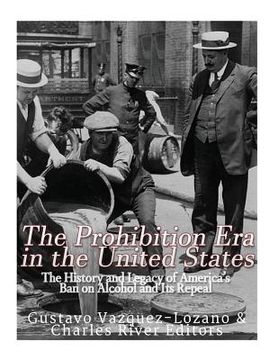The Prohibition Era in the United States: The History and Legacy of America's Ban on Alcohol and Its Repeal (in English)
Synopsis "The Prohibition Era in the United States: The History and Legacy of America's Ban on Alcohol and Its Repeal (in English)"
*Includes pictures *Includes online resources and a bibliography for further reading "Nothing so needs reforming as other people's habits." - Mark Twain The Prohibition Era in the United States ran between 1920 and 1933, but its background and legacy are so massive and wide-ranging it may be affirmed that the subject is adhered to the country s history, from its first years until the modern era. In this 13-year period, the entire nation was forcibly converted to a society of non-drinkers. The movement formed slowly, exploding in 1920. Once it had passed, its effects continued to be felt through the rest of the 20th century. To this day, it can be said that Prohibition teaches an important lesson. The 18th Amendment making Prohibition constitutional and the Volstead Act detailing its enforcement did not come out of the blue-it was neither an electoral occurrence, nor was it a quick and surprising attack by a one interest group taking another unprepared. It was actually the result of a long period of indoctrination, a century of struggles between two political, and above all, moral positions: those who supported Prohibition-the so-called "drys," and those who opposed it, partly because they thought it should not be a government prerogative to control individual freedoms, also known as "the wets." The first group believed Prohibition of liquor, intoxicants, and saloons was a necessary measure to eradicate the great evils that were a part of the nation's life: drunken and violent husbands, labor accidents due to alcoholism, shattered homes, battered wives, and the family s patrimony lost in a single day. The wets defended a legitimate industry that produced jobs and taxes. They spoke of economic interests that would be damaged and of respect for sacrosanct individual freedom. Above all, the wets argued how strange it was that a government dedicated to liberty and equality would regulate an individual's private behavior, determining what he could or could not ingest. Since the beginning, wine had been an inseparable part of American culture, from the saloons of the Wild West, the grape fields of the California valleys, the tables of homes throughout the territory, to the clubs of the big cities where the working class met to talk about politics. This in addition to other areas in which wine culture was an essential feature, such as social cohesion, the economy, and in the arts-especially where music and literature was concerned. What no one could ignore was that since the beginning of the 19th century, the United States had a serious problem with the bottle. The nation of Washington, Adams, and Franklin, for example, had one of the highest consumption rates in the world and thus had the highest rates of alcohol-related diseases and family violence. When women, the principal group affected, decided it was the moment to raise their voices en masse, alcohol became a political topic that polarized the country. In favor of moderation were the eminently rural white people of the inner country with an Anglo-Saxon background. At the other extreme was the urban, cosmopolitan population, close to the coasts and therefore, with a better perspective where the rest of the world was concerned. There were two visions, two different sets of morals, and two ways of understanding the role of government. However, the dividing line between the drys and wets cannot be so clearly marked, even today. There were both progressive and retrograde persons on either side. On the drys side -whom we might be tempted to caricature as moralistic and uneducated-were, for example, the suffragists, the brave women who fought for the right to vote, social justice, and a place in the politics of their country. On the wets side, those against Prohibition, were moralistic institutions, such as the Catholic Church and the Jewish rabbinic community.

